The Architecture and Film (6.0 hour version) course series covers the relation, if any, between cinema and architecture. Of all the fine arts, cinema and architecture seem to uniquely correspond due to their natures as both an art and a science. The course series more closely examines the role that the built environment often plays in creatively reinforcing or subverting expectations of the audience about cinematic narratives. 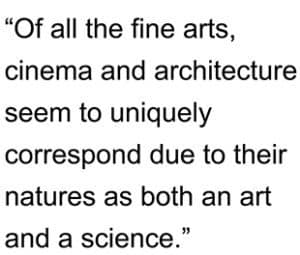 Part I reviews the conceptual, historical and technological correspondence between cinema and architecture. Parts II and III reviews filmmakers’ use of architectural typologies of space and form to craft distinctive film-grammars in service to cinematic narratives. Key concepts: film, narrative, artificial intelligence, CGI, technology, simulation, scale, historical precedent, architectural typology, and hyper-reality. Available soon to separately purchase as 2.0 hour courses ($14.99 each) or a 6.0 hour course series package ($39.99).
Part I reviews the conceptual, historical and technological correspondence between cinema and architecture. Parts II and III reviews filmmakers’ use of architectural typologies of space and form to craft distinctive film-grammars in service to cinematic narratives. Key concepts: film, narrative, artificial intelligence, CGI, technology, simulation, scale, historical precedent, architectural typology, and hyper-reality. Available soon to separately purchase as 2.0 hour courses ($14.99 each) or a 6.0 hour course series package ($39.99).
Part I: Do Architects Dream of Celluloid Buildings? (2.0 hour version)
– the seductive correspondence between cinema and architecture
Part II: The Architectural Competence in Film (2.0 hour version)
– the rules of film-grammars for cinematic built environments
Part III: The Best of Both Worlds (2.0 hour version)
– case studies in science fiction/fantasy films and television



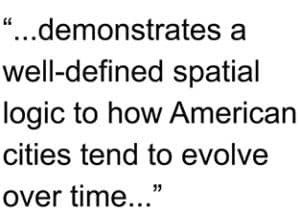 By understanding these concepts, we can better understand how “bedrock” urban attributes (such as block size and dwelling entrances) and common growth trends (such as strip malls and leapfrog development) play a role in the spatial logic of American cities. The objective of this course is to better understand the spatial implications of design decisions when intervening in the American city.
By understanding these concepts, we can better understand how “bedrock” urban attributes (such as block size and dwelling entrances) and common growth trends (such as strip malls and leapfrog development) play a role in the spatial logic of American cities. The objective of this course is to better understand the spatial implications of design decisions when intervening in the American city.
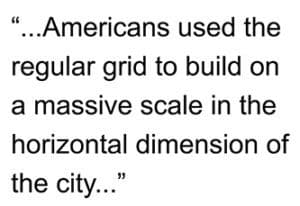 The course also compares the characteristics of block and street length in several American and European cities to demonstrate how Americans used the regular grid to build on a massive scale in the horizontal dimension of the city, which suburban sprawl has accentuated and abused since World War II. Finally, the course also discusses implications for sustainable cities in the 21st century.
The course also compares the characteristics of block and street length in several American and European cities to demonstrate how Americans used the regular grid to build on a massive scale in the horizontal dimension of the city, which suburban sprawl has accentuated and abused since World War II. Finally, the course also discusses implications for sustainable cities in the 21st century.
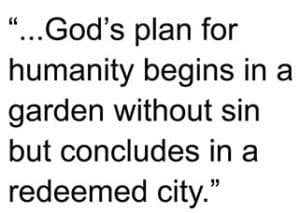 In The Old Testament, God was not anti-urban. Quite the opposite, there was evidence of God as the architect, designer, and planner. God’s plan for humanity begins in a garden without sin but concludes in a redeemed city. Christian writings of The New Testament intimately broaden and deepen this theme (1.25 hour course).
In The Old Testament, God was not anti-urban. Quite the opposite, there was evidence of God as the architect, designer, and planner. God’s plan for humanity begins in a garden without sin but concludes in a redeemed city. Christian writings of The New Testament intimately broaden and deepen this theme (1.25 hour course).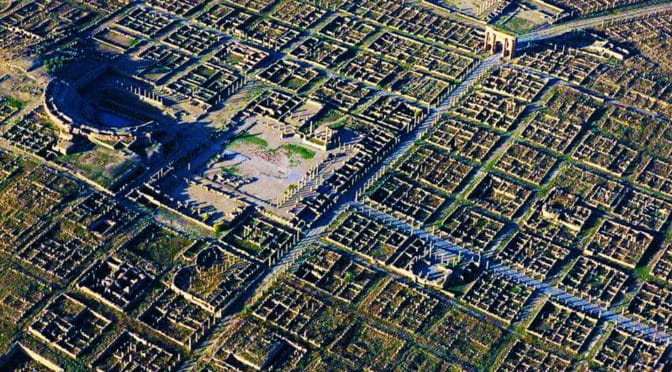
 The objective of this course is to understand how and why the regular grid has been a standard part of the town planning vocabulary around the world for nearly five millennia.
The objective of this course is to understand how and why the regular grid has been a standard part of the town planning vocabulary around the world for nearly five millennia.